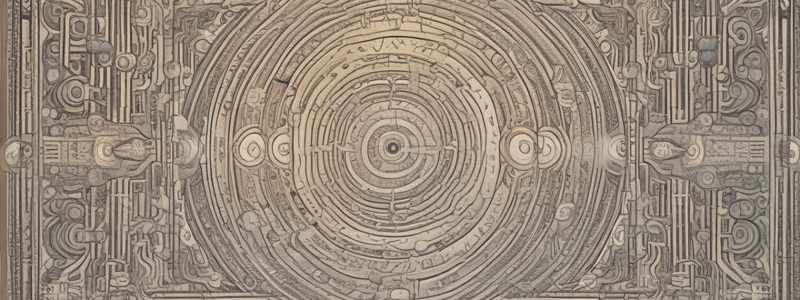Podcast
Questions and Answers
What is the primary function of the Skinner box?
What is the primary function of the Skinner box?
- To detect the animal's behaviour and deliver consequences (correct)
- To deliver primary reinforcers
- To study classical conditioning
- To weaken undesired behaviour
What is the outcome of positive reinforcement?
What is the outcome of positive reinforcement?
- The behaviour is strengthened, but only temporarily
- The behaviour is weakened, making it less likely to occur
- The behaviour remains unchanged
- The behaviour is strengthened, making it more likely to occur (correct)
What is the purpose of a clicker in animal training?
What is the purpose of a clicker in animal training?
- To startle the animal
- To weaken undesired behaviour
- To associate with primary reinforcers and become a conditioned reinforcer (correct)
- To deliver primary reinforcement
What is the role of sensors in the Skinner box?
What is the role of sensors in the Skinner box?
What is the fundamental concept behind instrumental conditioning?
What is the fundamental concept behind instrumental conditioning?
What is the difference between primary and secondary reinforcers?
What is the difference between primary and secondary reinforcers?
What is the outcome of negative reinforcement?
What is the outcome of negative reinforcement?
What is the purpose of B.F. Skinner's research?
What is the purpose of B.F. Skinner's research?
What is the role of the lever or key in the Skinner box?
What is the role of the lever or key in the Skinner box?
What is the outcome of reinforcement?
What is the outcome of reinforcement?
What is the primary function of punishment in terms of behaviour?
What is the primary function of punishment in terms of behaviour?
What is the term for the process by which an organism learns to respond differently to stimuli that signal different consequences?
What is the term for the process by which an organism learns to respond differently to stimuli that signal different consequences?
According to the Premack Principle, what can serve as a reinforcer for low-probability behaviours?
According to the Premack Principle, what can serve as a reinforcer for low-probability behaviours?
What is the term for the process by which an organism exhibits a learned behaviour in response to stimuli that resemble the original stimulus associated with reinforcement?
What is the term for the process by which an organism exhibits a learned behaviour in response to stimuli that resemble the original stimulus associated with reinforcement?
What is the purpose of measuring an individual's natural balance in their behaviours, called equilibrium or set-point?
What is the purpose of measuring an individual's natural balance in their behaviours, called equilibrium or set-point?
What is the primary difference between positive punishment and negative punishment?
What is the primary difference between positive punishment and negative punishment?
What is the term for the decrease in the effectiveness of a reinforcer due to the delay between the behaviour and the reinforcement?
What is the term for the decrease in the effectiveness of a reinforcer due to the delay between the behaviour and the reinforcement?
What is the primary goal of using reinforcement in behaviour modification?
What is the primary goal of using reinforcement in behaviour modification?
What is the term for the process by which an individual's behaviours are influenced by the availability of reinforcement?
What is the term for the process by which an individual's behaviours are influenced by the availability of reinforcement?
What is the assumption of the disequilibrium hypothesis?
What is the assumption of the disequilibrium hypothesis?
What is the primary goal of the therapeutic approach known as behaviour modification?
What is the primary goal of the therapeutic approach known as behaviour modification?
What is the term for the process by which an organism learns to associate certain cues with a physiological response?
What is the term for the process by which an organism learns to associate certain cues with a physiological response?
What is the primary difference between classical and instrumental conditioning?
What is the primary difference between classical and instrumental conditioning?
What is the term for the repeated powerful motivation to engage in purposeful behaviour despite having no survival value?
What is the term for the repeated powerful motivation to engage in purposeful behaviour despite having no survival value?
What is the primary limitation of learning theories of addiction?
What is the primary limitation of learning theories of addiction?
What is the role of the incentive and pleasure systems of the brain in addiction?
What is the role of the incentive and pleasure systems of the brain in addiction?
What is the primary difference between extinction and tolerance in the context of addiction?
What is the primary difference between extinction and tolerance in the context of addiction?
What is the term for the process by which an organism learns to perform a desired behaviour through the reinforcement of successive approximations?
What is the term for the process by which an organism learns to perform a desired behaviour through the reinforcement of successive approximations?
What is the primary goal of the token economy approach?
What is the primary goal of the token economy approach?
What is the primary difference between the IC and CC approaches?
What is the primary difference between the IC and CC approaches?
What is the primary function of reinforcement in instrumental conditioning?
What is the primary function of reinforcement in instrumental conditioning?
What is the fundamental concept behind secondary reinforcers?
What is the fundamental concept behind secondary reinforcers?
What is the primary purpose of the Skinner box?
What is the primary purpose of the Skinner box?
What is the primary difference between primary and secondary reinforcers?
What is the primary difference between primary and secondary reinforcers?
What is the primary function of a clicker in animal training?
What is the primary function of a clicker in animal training?
What is the primary goal of instrumental conditioning?
What is the primary goal of instrumental conditioning?
What is the primary difference between positive and negative reinforcement?
What is the primary difference between positive and negative reinforcement?
What is the primary concept behind conditioning?
What is the primary concept behind conditioning?
What is the primary function of the lever or key in the Skinner box?
What is the primary function of the lever or key in the Skinner box?
What is the primary concept behind reinforcement?
What is the primary concept behind reinforcement?
What is the primary purpose of generalisation in behaviour modification?
What is the primary purpose of generalisation in behaviour modification?
What is the primary difference between positive and negative punishment?
What is the primary difference between positive and negative punishment?
What is the primary assumption of the disequilibrium hypothesis?
What is the primary assumption of the disequilibrium hypothesis?
What is the primary purpose of the Premack Principle in behaviour modification?
What is the primary purpose of the Premack Principle in behaviour modification?
What is the primary difference between discrimination and generalisation?
What is the primary difference between discrimination and generalisation?
What is the primary factor affecting the effectiveness of reinforcement?
What is the primary factor affecting the effectiveness of reinforcement?
What is the primary goal of reinforcement in behaviour modification?
What is the primary goal of reinforcement in behaviour modification?
What is the primary difference between reinforcement and punishment?
What is the primary difference between reinforcement and punishment?
What is the primary purpose of measuring an individual's natural balance in their behaviours?
What is the primary purpose of measuring an individual's natural balance in their behaviours?
What is the primary limitation of the disequilibrium hypothesis?
What is the primary limitation of the disequilibrium hypothesis?
What is the primary mechanism by which shaping reinforces desired behaviours?
What is the primary mechanism by which shaping reinforces desired behaviours?
What is the primary goal of the therapeutic approach known as behaviour modification?
What is the primary goal of the therapeutic approach known as behaviour modification?
What is the primary role of the token economy approach?
What is the primary role of the token economy approach?
What is the primary difference between classical and instrumental conditioning?
What is the primary difference between classical and instrumental conditioning?
What is the primary limitation of learning theories of addiction?
What is the primary limitation of learning theories of addiction?
What is the primary role of the incentive and pleasure systems of the brain in addiction?
What is the primary role of the incentive and pleasure systems of the brain in addiction?
What is the primary mechanism by which instinctive drift limits the range of novel behaviours?
What is the primary mechanism by which instinctive drift limits the range of novel behaviours?
What is the primary goal of self-behaviour modification?
What is the primary goal of self-behaviour modification?
What is the primary role of Ayllon's study in the context of behaviour modification?
What is the primary role of Ayllon's study in the context of behaviour modification?
What is the primary mechanism by which addiction progresses through stages?
What is the primary mechanism by which addiction progresses through stages?
Study Notes
Instrumental Conditioning
- Developed by B.F. Skinner, also known as operant conditioning
- Uses the Skinner box, a small chamber with a lever or key, devices for delivering food or reinforcers, and sensors to detect the animal's behaviour
Key Concepts
- Reinforcement: the process of strengthening a behaviour by delivering a consequence that increases the likelihood of the behaviour occurring again in the future
- Positive Reinforcement: a desirable consequence is presented following the behaviour
- Negative Reinforcement: an aversive consequence is removed following the behaviour
- Secondary Reinforcers: stimuli that acquire their reinforcing properties through association with primary reinforcers (e.g., a clicker paired with food delivery)
Punishment
- Punishment: presenting an aversive consequence or removing a desirable stimulus contingent upon the occurrence of behaviour, which decreases the probability of the behaviour occurring again
- Positive Punishment: involves presenting an aversive stimulus following the behaviour
- Negative Punishment: removal of a desirable stimulus following the behaviour
Factors Affecting Reinforcer Effectiveness
- Amount of Reinforcement: the amount of reinforcement received can impact the effectiveness of the reinforcer
- Motivational Need of Reinforcer: the degree to which the reinforcer satisfies a biological or physiological need
- Contrast Effects: the difference between the reinforcement and the absence of reinforcement
- Delay of Reinforcement: the time between the behaviour and the presentation of the reinforcement
Generalisation and Discrimination
- Generalisation: the learned behaviour is exhibited in response to stimuli that resemble the original stimulus associated with reinforcement
- Discrimination: the organism learns to respond differently to stimuli that signal different consequences
Updates
- Relativity of Reinforcement: the value of a reinforcer can vary depending on the context
- Premack Principle: high-probability behaviours can serve as reinforcers for low-probability behaviours
- Disequilibrium Hypothesis: individuals have a natural balance in their behaviours, and reinforcement can be used to increase or decrease certain behaviours
Applications
- Behaviour Modification: a therapeutic approach that aims to change or modify undesirable behaviours
- Token Economy: a system that uses tokens or symbols to reinforce desirable behaviours
- Self-Behaviour Modification: uses the ABC approach to change behaviour and reinforces it
Addiction
- Addiction: the repeated powerful motivation to engage in purposeful behaviour
- Stages of Addiction: initiation, maintenance, and addiction
- Role of Classical Conditioning: associates drug-related cues with physiological cues
- Role of Instrumental Conditioning: reinforces drug-seeking behaviours through rewarding effects of drugs
Limitations of Learning Theories of Addiction
- Oversimplification: based on animal research, which may not translate to humans
- Automatic Processes: do not take into account human reflective processes
- Factors that Make Some Drugs More Addictive: ability to activate the incentive and pleasure systems of the brain, tolerance, withdrawal effects, and long-lasting changes in brain incentive systems
Classical vs Instrumental Conditioning
- Key Differences: classical conditioning elicits involuntary and automatic responses, whereas instrumental conditioning responses are voluntary
Instrumental Conditioning
- Developed by B.F. Skinner, also known as operant conditioning
- Uses the Skinner box, a small chamber with a lever or key, devices for delivering food or reinforcers, and sensors to detect the animal's behaviour
Key Concepts
- Reinforcement: the process of strengthening a behaviour by delivering a consequence that increases the likelihood of the behaviour occurring again in the future
- Positive Reinforcement: a desirable consequence is presented following the behaviour
- Negative Reinforcement: an aversive consequence is removed following the behaviour
- Secondary Reinforcers: stimuli that acquire their reinforcing properties through association with primary reinforcers (e.g., a clicker paired with food delivery)
Punishment
- Punishment: presenting an aversive consequence or removing a desirable stimulus contingent upon the occurrence of behaviour, which decreases the probability of the behaviour occurring again
- Positive Punishment: involves presenting an aversive stimulus following the behaviour
- Negative Punishment: removal of a desirable stimulus following the behaviour
Factors Affecting Reinforcer Effectiveness
- Amount of Reinforcement: the amount of reinforcement received can impact the effectiveness of the reinforcer
- Motivational Need of Reinforcer: the degree to which the reinforcer satisfies a biological or physiological need
- Contrast Effects: the difference between the reinforcement and the absence of reinforcement
- Delay of Reinforcement: the time between the behaviour and the presentation of the reinforcement
Generalisation and Discrimination
- Generalisation: the learned behaviour is exhibited in response to stimuli that resemble the original stimulus associated with reinforcement
- Discrimination: the organism learns to respond differently to stimuli that signal different consequences
Updates
- Relativity of Reinforcement: the value of a reinforcer can vary depending on the context
- Premack Principle: high-probability behaviours can serve as reinforcers for low-probability behaviours
- Disequilibrium Hypothesis: individuals have a natural balance in their behaviours, and reinforcement can be used to increase or decrease certain behaviours
Applications
- Behaviour Modification: a therapeutic approach that aims to change or modify undesirable behaviours
- Token Economy: a system that uses tokens or symbols to reinforce desirable behaviours
- Self-Behaviour Modification: uses the ABC approach to change behaviour and reinforces it
Addiction
- Addiction: the repeated powerful motivation to engage in purposeful behaviour
- Stages of Addiction: initiation, maintenance, and addiction
- Role of Classical Conditioning: associates drug-related cues with physiological cues
- Role of Instrumental Conditioning: reinforces drug-seeking behaviours through rewarding effects of drugs
Limitations of Learning Theories of Addiction
- Oversimplification: based on animal research, which may not translate to humans
- Automatic Processes: do not take into account human reflective processes
- Factors that Make Some Drugs More Addictive: ability to activate the incentive and pleasure systems of the brain, tolerance, withdrawal effects, and long-lasting changes in brain incentive systems
Classical vs Instrumental Conditioning
- Key Differences: classical conditioning elicits involuntary and automatic responses, whereas instrumental conditioning responses are voluntary
Studying That Suits You
Use AI to generate personalized quizzes and flashcards to suit your learning preferences.
Description
This quiz explores the concept of instrumental conditioning, developed by B.F. Skinner, where behavior is strengthened or weakened by its consequences. Learn about the Skinner box and key concepts like reinforcement.




